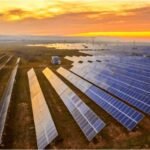Understanding Solar Energy
Solar energy harnesses the power of the sun’s rays to generate electricity, providing a renewable and sustainable energy source for a variety of applications. At its core, solar energy systems utilize photovoltaic (PV) technology, which converts sunlight directly into electricity. When sunlight strikes photovoltaic cells, it excites electrons, creating an electric current. This electricity can then be used to power homes, businesses, or fed back into the grid, contributing to energy independence and reducing reliance on traditional fossil fuels.
The benefits of incorporating solar energy into residential and commercial applications are multifaceted. Environmentally, solar energy offers a significant reduction in carbon emissions compared to conventional energy sources. The transition to solar energy mitigates the effects of climate change by decreasing greenhouse gas emissions, which are primarily produced by burning fossil fuels for energy. Additionally, solar energy systems require minimal water use compared to other energy generation methods, making them a suitable option in areas facing water scarcity.
From an economic perspective, adopting solar energy can lead to substantial cost savings. Solar installations can significantly reduce electricity bills, and many regions offer financial incentives, such as tax credits and rebates, to encourage their implementation. By generating your own electricity, you are less susceptible to fluctuating utility rates. Furthermore, investing in solar systems can increase property value, making solar energy not only an environmentally friendly option but a financially wise one as well.
Ultimately, understanding solar energy and its underlying technology is crucial for anyone looking to adopt it for their home or business. With its ability to provide clean power and enhance energy independence while offering considerable economic benefits, solar energy is becoming an increasingly attractive solution for energy needs.
Assessing Your Energy Needs
Before selecting a solar system for your home or business, it is crucial to assess your current and future energy needs. This assessment will guide you in determining the appropriate size and capacity of the solar system that will serve your requirements effectively. Start by analyzing your electricity bills over the past year. These statements provide a clear indication of your monthly energy consumption patterns, helping you identify the average kilowatt-hours (kWh) used each month. Look for seasonal variations in your usage, as these can significantly influence the overall demand and should be accounted for when planning your solar system.
Next, it is important to understand your peak usage times. This involves identifying the hours of the day when your energy consumption reaches its highest levels. For residential users, this may occur in the evening when household members return home and use multiple appliances simultaneously. For businesses, peak hours could coincide with operational hours when equipment and machinery are in full use. Understanding these timeframes will enable you to tailor your solar energy system to offset your peak consumption effectively, maximizing your investment.
Additionally, consider any potential lifestyle or business changes that may alter your energy consumption in the future. For instance, the addition of new appliances, electric vehicles, or expansion plans for a business can lead to significant increases in energy needs. By anticipating these changes, you can select a solar system that not only meets your current demands but also accommodates future growth. This proactive approach will ensure that your solar energy system remains effective and efficient, providing you with sustainable energy for years to come.
Evaluating Roof and Site Suitability
When considering the installation of a solar system, it is crucial to thoroughly evaluate the suitability of your roof or property. The first factor to assess is the roof orientation. Ideally, solar panels should face true south in the Northern Hemisphere to maximize sunlight exposure. However, east and west orientations can also be effective, although they may result in reduced energy production. A simple way to determine your roof’s orientation is to use a compass or a smartphone app designed for this purpose.
Next, it’s essential to evaluate any potential shading issues that could impact the efficiency of your solar panels. Tall trees, nearby buildings, and other obstructions can cast shadows on the panels, significantly reducing their operational effectiveness. Conducting a shading analysis, preferably with the assistance of a professional installer, will provide an accurate assessment of how much shade will affect your solar energy system at different times of the day and year.
Additionally, the structural integrity of your roof must be considered. Solar panel installations can add extra weight, so it is vital to ensure that your roof is capable of supporting this load. An inspection by a qualified contractor can help identify any weaknesses or repairs that may be necessary before installation. The condition of the roofing material is also important; if your roof is nearing the end of its lifespan, it may be prudent to address this before installing solar panels, as replacing or repairing the roof afterward can be costly and disruptive.
Finally, evaluate the available space for installing solar panels. Sufficient space is necessary not only for the panels themselves but also for other components of the solar energy system, such as inverters and batteries. Ensuring you have adequate space will facilitate optimal performance and accessibility for maintenance and monitoring after installation.
Types of Solar Systems
When considering the implementation of solar energy solutions, it is essential to understand the different types of solar systems that are available: grid-tied, off-grid, and hybrid systems. Each type of system has its unique characteristics, advantages, and disadvantages, making some more suitable than others depending on individual energy needs, geographical location, and budget constraints.
The grid-tied solar system is the most common type used in residential and commercial settings. This system is connected to the local electricity grid, allowing for the seamless exchange of power. When the solar panels generate surplus energy, it is fed back into the grid, and homeowners can receive credits, often referred to as net metering. This arrangement can significantly lower electricity bills. However, a downside is that grid-tied systems do not provide power during outages, as they rely on the grid for electricity.
In contrast, the off-grid solar system operates independently of the utility grid. It is ideal for remote locations that are not connected to grid power or where users desire independence from traditional energy sources. Off-grid systems require battery storage to ensure a constant power supply, which can be a significant upfront investment. While they provide greater energy autonomy, the cost and maintenance of batteries can be substantial, and users must carefully manage their energy consumption.
Lastly, the hybrid solar system combines elements from both grid-tied and off-grid systems. It connects to the grid while also incorporating battery storage, allowing for energy independence during outages or peak demand times. This versatility offers users the best of both worlds, providing security and economic benefits. However, hybrid systems can be more complex to install, requiring careful planning and higher initial costs.
In summary, selecting the right solar system hinges on analyzing individual energy requirements, location specifics, and budget. Understanding these three main types will assist homeowners and businesses in making an informed decision that maximizes the benefits of solar energy.
Choosing the Right Solar Panels and Equipment
When venturing into solar energy solutions for your home or business, the selection of solar panels and associated equipment is pivotal. The market offers a diverse range of solar panels, inverters, and other essential components, making it crucial to understand the specifications and features that best suit your energy needs. The efficiency rating of solar panels is a primary factor to consider. Higher efficiency panels convert more sunlight into electricity, making them ideal for areas with limited roof space.
Warranties are another key aspect in the selection process. A reputable solar panel manufacturer should offer warranties ranging from 25 years for product performance to shorter terms for workmanship. Such warranties can provide assurance of the durability and longevity of your investment. Certifications, such as those from the International Electrotechnical Commission (IEC) or Underwriters Laboratories (UL), can further validate the quality of the solar equipment, ensuring it meets industry standards.
Aesthetics play an important role as well, particularly for residential installations where visual appeal may be a consideration. There are various styles of solar panels available, including traditional models and sleek, integrated designs that blend seamlessly with your roof. Assessing your installation requirements is essential as well; factors such as roof orientation, tilt, and shading can influence the type and number of panels needed to achieve optimal performance.
In summary, thoroughly evaluating the types of solar panels and their specifications, including efficiency ratings, warranties, and certifications, will empower you to make an informed choice. By considering aesthetics and installation parameters, you can select the right combination of solar panels and equipment that aligns with your energy goals and operational needs, ultimately leading to a successful transition to solar energy.
Understanding Financial Options and Incentives
When considering the installation of a solar system for your home or business, understanding the financial implications is crucial. The upfront costs of purchasing and installing a solar energy system can be significant; however, several financing options are available to alleviate this burden. Homeowners and businesses may choose to buy their solar systems outright, which involves the highest initial expenditure, or opt for financing methods such as solar loans or leasing. Solar loans allow individuals to spread their payments over a set term, while leasing provides a way to utilize solar energy without incurring substantial initial costs, as the solar provider typically owns the system.
Furthermore, various tax credits, rebates, and incentives exist depending on your location, significantly impacting the overall cost of solar energy systems. For instance, the federal solar tax credit (Investment Tax Credit) offers a percentage deduction on your federal taxes based on the cost of the system, incentivizing the transition to solar energy. Many states and local governments also offer additional rebates or performance-based incentives to encourage solar adoption. These financial incentives serve to increase the overall affordability of solar energy solutions, making them a viable option for many consumers.
Long-term financial benefits should also be thoroughly examined when considering solar system installation. Although the initial investment may be high, the long-term savings on energy bills can be considerable. Home and business owners can expect reduced utility costs over the lifespan of the solar system, which averages around 25 years. Additionally, installing solar energy systems contributes positively to property value, an important factor to consider for both homeowners and investors. With potential tax savings, rebates, and long-term savings in mind, evaluating the financial options and incentives related to solar installations can lead to a more informed decision-making process.
Hiring a Reputable Solar Installer
When considering the installation of a solar energy system, selecting a reputable solar installer is critical to ensure a successful and efficient installation. This process begins with thorough research about potential installers’ credentials. Look for professionals who are certified by recognized organizations such as the North American Board of Certified Energy Practitioners (NABCEP) or have relevant state licenses. These certifications signify a level of expertise and commitment to quality standards, which are essential for a sustainable solar system.
Reading customer reviews can provide a wealth of information about an installer’s reliability and quality of work. Online platforms such as Yelp, Google Reviews, and the Better Business Bureau offer insights into past customers’ experiences. Pay attention to feedback regarding the installation process, customer service, and the longevity of the systems installed. Consistency in positive reviews may indicate that the installer delivers satisfactory services, while frequent negative comments should raise red flags.
Obtaining multiple quotes from different solar companies can facilitate informed decision-making. When comparing quotes, focus on the overall value rather than just the price. Evaluate what each installation includes, such as warranties, system monitoring, and maintenance services. A lower upfront cost might not guarantee long-term savings, particularly if the equipment is subpar or if post-installation support is lacking.
During the consultation process, it is prudent to ask pertinent questions to gauge the installer’s knowledge and approach to solar energy solutions. Inquire about the types of solar panels and inverters they recommend, their installation timeline, and how they handle permits and inspections. A reputable installer will be transparent, providing detailed answers and demonstrating a clear understanding of both the technical and regulatory aspects involved in solar energy systems. By following these steps, homeowners can ensure they make an informed choice in selecting a qualified solar installer.
Preparing for Installation
Before the installation of a solar system can occur, several essential steps must be taken to ensure a smooth process. One of the first actions that homeowners or business owners should undertake is securing the necessary permits. Local regulations vary significantly, and it is crucial to familiarize yourself with the specific requirements in your area. This may involve submitting an application to the local government or utility company and obtaining any required approval before work commences. Engaging a reputable solar installer can be beneficial, as they often have experience navigating this process and can assist with securing the appropriate permits.
Understanding the installation timeline is another critical aspect of preparation. Typically, the installation of a solar system can vary in duration based on system complexity, weather conditions, and the availability of materials. It is advisable to discuss the anticipated timeline with your solar provider to set realistic expectations and minimize disruptions to your daily activities. This proactive approach allows you to better plan around the installation process, accommodating any needs that may arise during this period.
Additionally, homeowners and business owners may need to make modifications to their property in preparation for the solar system installation. This could involve clearing any obstructions on the roof, ensuring that trees or other structures do not block sunlight, or reinforcing roof structures if necessary. Proper communication with the installation team is also crucial during this phase. Clearly outline your expectations, any concerns you may have, and ensure that you understand the installation process and what will be required on your end.
By adequately preparing for the installation of your solar system, you can facilitate a more efficient process and ensure that the transition to solar energy is seamless and effective.
Maintenance and Monitoring of Your Solar System
Ensuring the longevity and efficiency of your solar system requires regular maintenance and effective performance monitoring. Solar energy systems, while generally low-maintenance compared to other energy options, still necessitate periodic checks to maximize energy production and prevent potential issues. One of the first steps in maintaining your solar system is to establish a schedule for routine inspections. This could be done seasonally or at least once a year, depending on the local climate and environmental factors that may affect the solar panels.
When selecting a maintenance service, it is essential to look for providers with comprehensive experience in the solar industry. Ask questions about their certification, experience, and the specific services offered. A reliable maintenance plan should include cleaning the solar panels, checking the inverter and electrical connections, and ensuring that the mounts and fixtures are secure. Regular cleaning is especially important, as dirt, leaves, and other debris can significantly decrease the system’s efficiency.
Monitoring the performance of your solar system makes it easier to track energy production and identify problems early. Many modern solar systems come equipped with monitoring technology that allows homeowners and businesses to evaluate the amount of energy generated and consumed. Utilizing these tools is vital for detecting anomalies, such as decreased production, which may necessitate further investigation or repairs.
It is also advisable to familiarize yourself with common issues that could arise with your solar system, such as shading from trees, malfunctioning inverters, or faulty wiring. Being aware of these signs can help you act swiftly and prevent minor issues from escalating into significant problems. Ultimately, regular maintenance and diligent monitoring not only enhance the performance of your solar system but also contribute to its longevity, ensuring that you get the most out of your solar investment.


